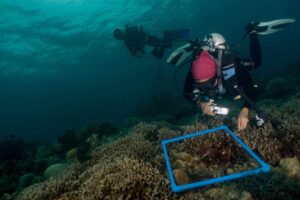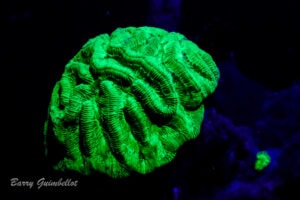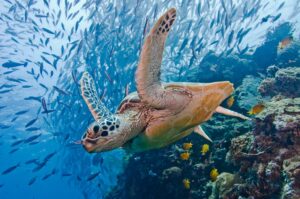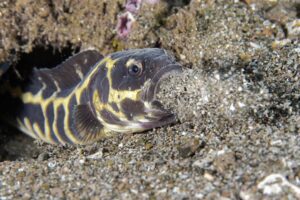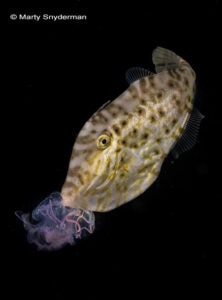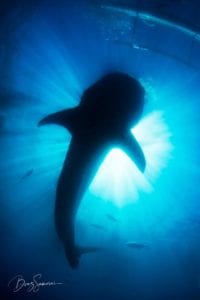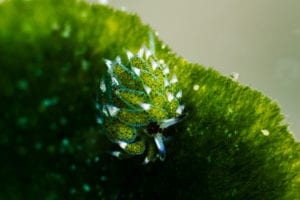[vc_row bg_style=”stretch”][vc_column width=”1/2″ css=”.vc_custom_1510908424132{margin-bottom: 0px !important;padding-top: 0px !important;padding-right: 20px !important;padding-bottom: 0px !important;padding-left: 20px !important;background-color: #ffffff !important;border-radius: 5px !important;}”][vc_column_text css=”.vc_custom_1585931507266{padding-bottom: 25px !important;}”]By Marty Snyderman
Collectively speaking, the world’s approximately 600 species of octopuses, squids, cuttlefishes and nautiluses are known as cephalopods. Types of mollusks, the members of this class are considered to be the most intelligent of all invertebrates, and when you watch them “do their thing”, it is hard to argue against that assessment.
Fortunately, for all of us that dive with Atlantis, a variety of cephalopods are seen on a regular basis. A partial list includes the bigfin reef squid, bobtail squid, two-tone pygmy squid, flamboyant cuttlefish, broadclub cuttlefish, and the venomous blue ring octopus and poison ocellate octopus.
The term cephalopod is derived from the Greek for “head” and “foot.” The “head foot” reference is made in acknowledgement of the two most prominent characteristics of cephalopods, the extremely enlarged head and foot-like arms. The foot has been modified into sucker-bearing arms that are used for mobility, ensnaring prey and manipulation.
The hard shell so characteristic of many other mollusks is missing or greatly reduced in most cephalopods.
With the exception of nautiluses, the arms of cephalopods are covered with one or more row of suckers. Each contains small hooks or other adhesive structures that are used for ensnaring prey. While octopods have eight arms, squids and cuttlefishes have eight arms and two tentacular-clubbed arms making a total of ten appendages, and nautiluses have as many as 90 arms. While squids and cuttlefishes primarily use their arms and suckers for capturing fishes and other mid-water animals, octopuses use theirs to trap and pin prey against solid substrate as they primarily feed on bottom dwelling invertebrates such as other mollusks, arthropods and worms.
Most cephalopods possess a hard parrot-like beak that can deliver an immobilizing toxin into the body of prey once it has been bitten.
The senses of smell, sight and touch are extremely well developed in cephalopods. At the end of each arm octopuses are equipped with well-developed chemoreceptors that help detect prey and direct it toward their mouths. In fact, it is often said that octopods possess eight “noses.”
In many cephalopods the art of camouflage often includes the ability to control and alter the texture of their skin in addition to its color. The ability to change color is also used as a means of communication. Vision plays a key role in determining the changes in color and skin texture. Specialized pigment cells controlled by the muscular and vascular systems and that are known as chromatophores enable cephalopods to rapidly change their color.
At times, the bodies of cephalopods ripple and flash in spectacular color displays. Color flashing is most often utilized during elaborate courtship rituals and when competing males challenge each other as they pursue females.
Masters of escape, most cephalopods have evolved ink sacs that contain a thick substance of dark ink that forms disorienting, smoke-screen like clouds of black ink that is intended to confuse predators. The chemical make-up of the ink also serves to dull the olfactory receptors of many potential predators such as include moray eels, larger fishes and even marine mammals.
In cephalopods, the sexes are separate. Fertilization is internal and females lay their fertilized eggs individually or in clusters inside of egg casings that are attached to the substrate. The eggs are typically translucent and slender, and appear in a variety of colors. While squids lay their tube-like eggs on the ocean floor and leave them, female octopuses and cuttlefishes lay their eggs in grape-like clusters from the ceiling of their dens. Octopuses and cuttlefishes guard, aerate and clean their eggs for several weeks until they hatch. These females do not leave their dens during this time and consequently, they lose more than 50 percent of their body weight and die soon after the young hatch.
You have a chance of seeing a number of different cephalopods while diving at Atlantis Dumaguete or Atlantis Puerto Galera. We even nicknamed one site Cephalopod City![/vc_column_text][/vc_column][vc_column width=”1/2″][vcex_image_grid columns=”3″ columns_gap=”5″ title=”no” image_ids=”9681,9682,9683,9684,9685,9686,9687″][/vc_column][/vc_row]


